SIGNS OF THE TIMES
This section aims to capture the quirky, innovative, emotive, historical and other signs. Records of a society that don't quite fit in anywhere else.
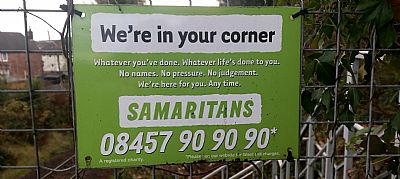
This is not just another sign on a fence. It offers a connection to peace of mind in times of turmoil, perhaps even saving a life. Even if you don't need it, you may know someone who does or come across someone in dispair. Make a mental note of where you have seen such a sign or even on this website. Remember SAMARITANS can make a difference.
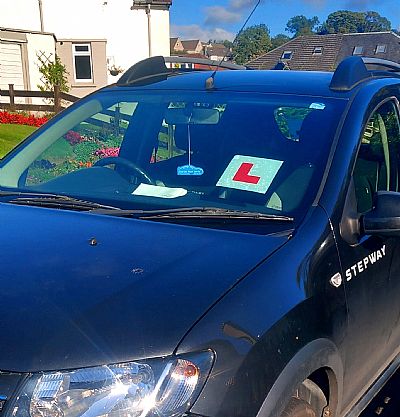
This unbelievable "L" plate was seen in the Vale and beyond during mid-2024. Who cares if the novice driver can't see the whole road ahead. And why should the instructor bother to see much at all!

There are times when one feels that Christmas is overwhelming. Why all the hype? This signs appeared in Morrisons in the first week of October suggesting that we can get through without Christmas. Well maybe for a while longer. Let it come when it should - in December!
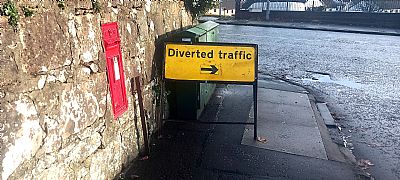
These diversion signs abound. Evidently erected by those carefully selected for their unbiased ignorance of how traffic circulates and diligently located where they mean nothing at all. This one may have been located at the foot of Cardross Road, Renton, in late 2024 to keep customers away from the newly reopened Aldi in the hope that they will instead go to Lidl in Dumbarton until the new Alexandria Lidl branch is ready.

Well, if you have such a posh car, you would also park away from everyone else.

This sign appeared on a tree in the small landscaped area where Alexander Street approaches the Leven. There have been attempts over 2023 to improve the setting where one can find benches from which to admire this beautiful corner of the river. Such improvements have included wooden planters. You can feel the disgust and frustration of the person who put up the sign at the theft of the first plants in them. Theft of plants is an extraordinary crime. One tends to think of those who admire plants and gardens as being above such things.
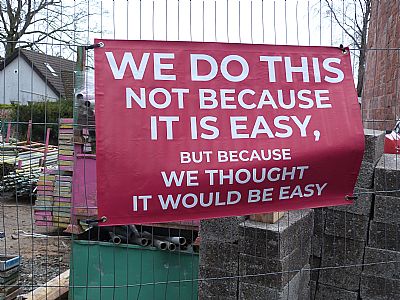
If you have ever built your own house or even had one built for you you will be able to relate to this sign seen in Balloch 2025.

Courier companies are not known for their toilet facilities. Evri is no different. It still doesn't have a logo even after having morphed out of its Hermes origins some years ago. They seem to experiment instead with differing fonts. Whoever did this one obviously has a sense of humour.
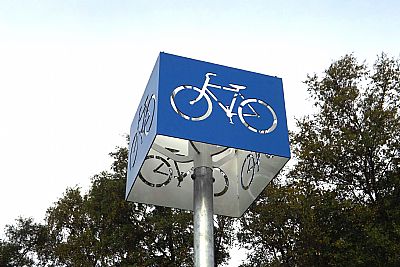
A very welcome sign for any cyclist with a mechanical problem or flat tyre. This one is alongside the Bonhill Bridge on the towpath which serves today as a cycle and walking path. Below it is a comprehensive array of repair equipment including a pump. All provided by SUSTRANS.
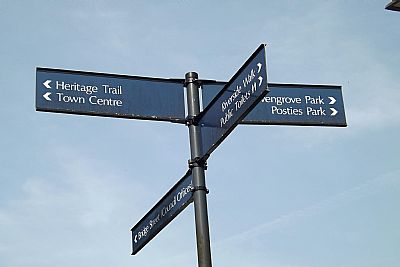
A very clear and useful sign as one comes up from the Riverside Lane carpark in central Dumbarton to Dumbarton Bridge. But hang on - there is something odd here. The top sign has been turned around to point in the opposite direction. How many innocent tourists heading for Levengrove Park are ending up back in the town centre.
Also see index.asp?pageid=719120 for local walks.
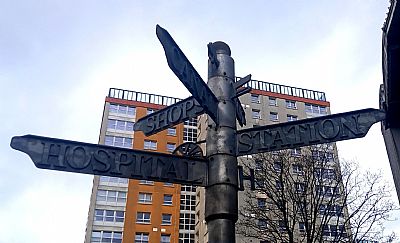
A direction sign outside Dalmuir Station rather gets lost amongst the railings and ramps etc. It was most probably meant to be painted a bright colour, but never was, instead remaining a dull metallic hue. Notice how each worded pointer has a symbol on the opposite side of the pole.
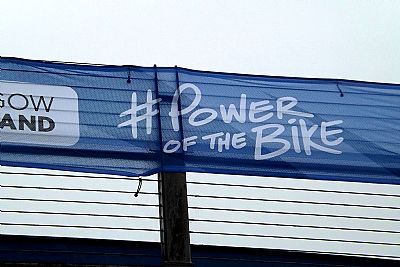
Balloch Bridge. August 2023. Our contribition to Cycling World Championships, Glasgow
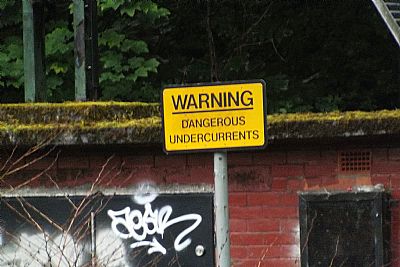
There are times when the Leven is very obviously treacherous. And there are times when the water is low. It can be misleading and seem to offer a lovely cool place to be on a summer day and some points along its length seem to be easy places to wade across instead of the long way around. Most rivers that meander have shallow sides where silt and stones have been deposited and these are generally shallower, but on the other side, usually the shortest course for the water flow, it is deeoer. While it may seem at times to be narrow, that flow is not just deeper, but flowing fast at its lower levels. This sign is across from Alexandra and India Streets.
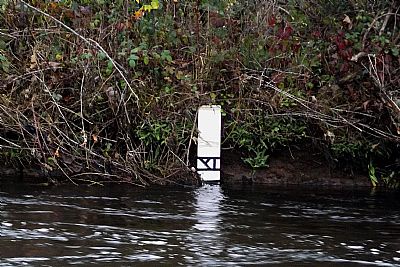
This is not as cryptic as it may at first seem. A leg of the Roman numeral XI has disappeared. This is a depth gauge for the River Leven up near Bonhill Bridge. Heavy rains in September 2023 meant it was actually submerged and Storm Babet the following month hardly helped, but this is a more "normal" height. Also see FLOODING index.asp?pageid=734104
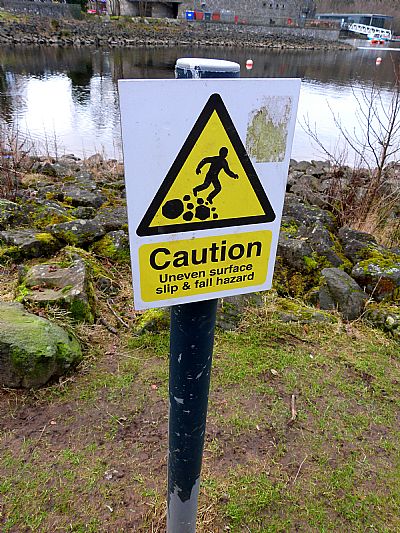
Really? Lomond Shores cautionary signage.
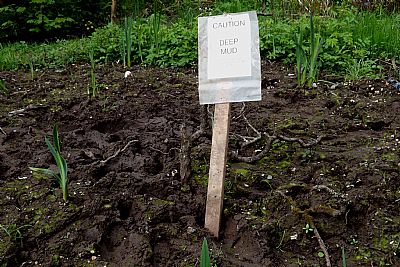
Very helpful. Just in case you hadn't noticed. "CAUTION DEEP MUD".
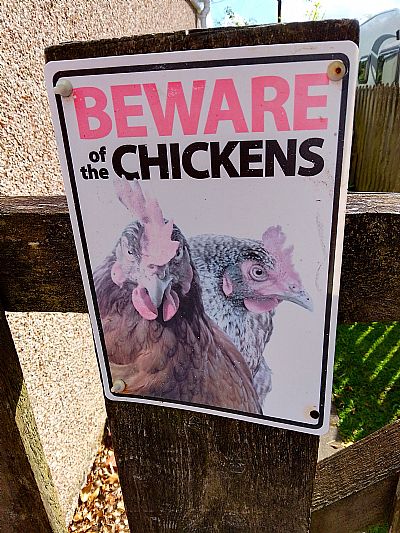
Need we say more?

Cooperative sentiments. A sign in the men's loo at the Clydebank CoOp.
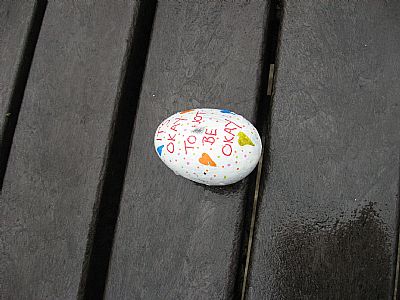
Signs come in a great many forms. This one on a pebble left on a picnic table next to the Leven shows that someone cares, even if they have never met you. A thoughful gesture if you are feeling down.
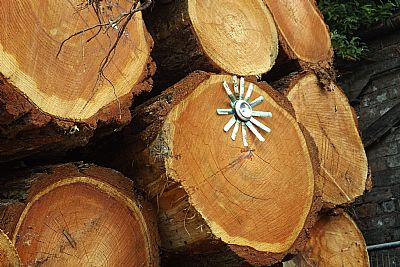
Perhaps you know who does this. A rather mysterious star appears all over the Vale, mainly down near the river. Made from discarded drink cans and nailed on trees. Well this is a tree, isn't it? Lumber on a trailer awaiting delivery. Such metal stars usually incur some disgust - litter up a tree - but just sometimes, instead produce a smile.
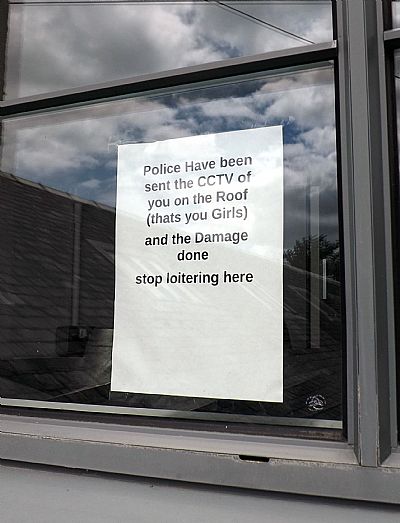
Do you know where this one is? It is a public building in Dumbarton. It is but one climbed by adventurous youth. The problem is not just that of damage to a building, but danger to those involved.
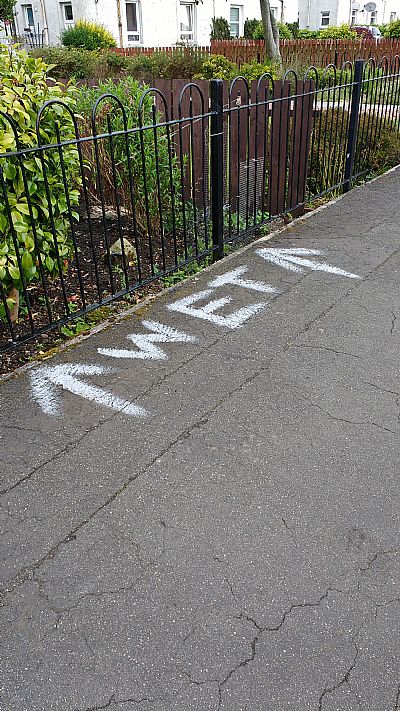
"Wet" paint sign seen in Hillfoot in Renton. Huh!? Hope it was noticed before someone got black paint from the railings on them. But what about the white paint on one's shoes?

OK, this comes from the Mitchell Library in Glasgow. But it does epitomise our consciousness and interpretation of our world in the current generation.
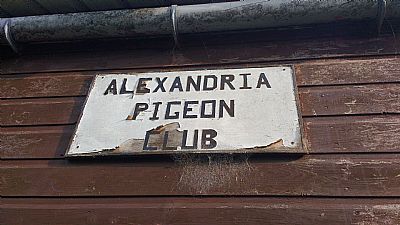
An old Alexandria Pigeon Club sign in Alexander Street. This is on the old club house. itself rare as a timber building. Now the hobby is also becoming less popular and pigeons are seen as a pest rather than a prized possession.
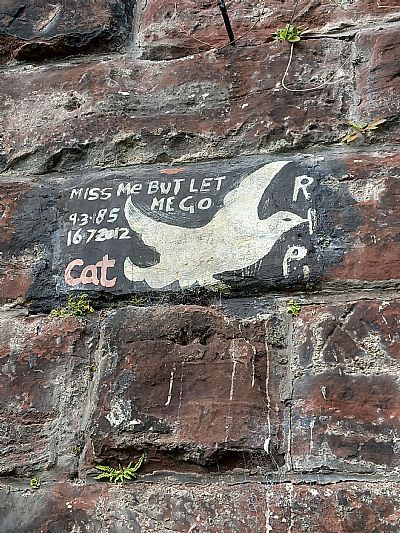
Some signs are personal although very evidently meant to be public. This one on the railway embankment along the Leven is moving, albeit confusing.
The tow path along the Leven is one of several places that suffers a great deal from gaffiti, some simply naive and crude; much really quite disgusting. The Council come in and remove it. Quite what is "public art" or even "historical" sentiment is very subjective. Graffiti is even a subject often put as somthing to analyse on conservation or art courses at university level. How should we react to the following?
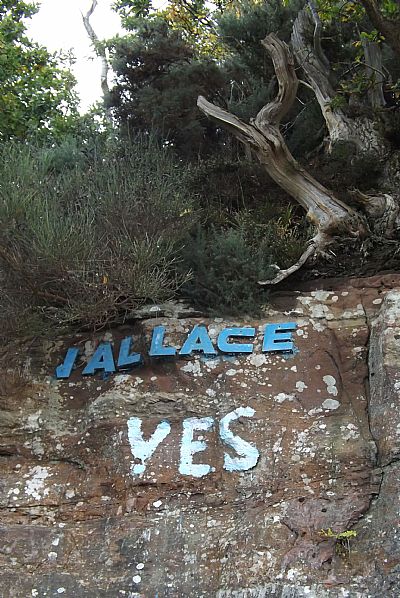
Havoc Hole. Daubed slogans have ranged from Yes to Scottish Independence to stop the developers destroying this historic and socially important site. There is actually no evidence that Wallace ever came to Havoc Hole, yet he retains a strong association with it.
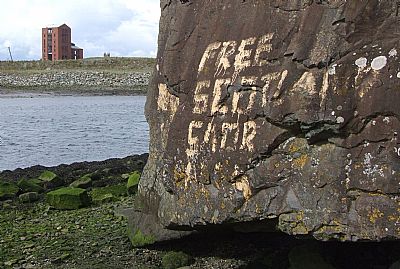
Graffiti on the boulders below Dumbarton Rock. When is such daubing legitimate and when is it pure vandalism? When Historic Environment Scotland inspected graffiti on the Rock some years ago they had quite a lot removed. What was allowed to remain included markers for the bouldering club - and this, based on the hsitorical context. This has been here for many years, expressing strong support for Scotland's independence.
(That building in the background is now a historical memory; the Allied Distillery tower which remained long after the rest of the premises had been demolished).
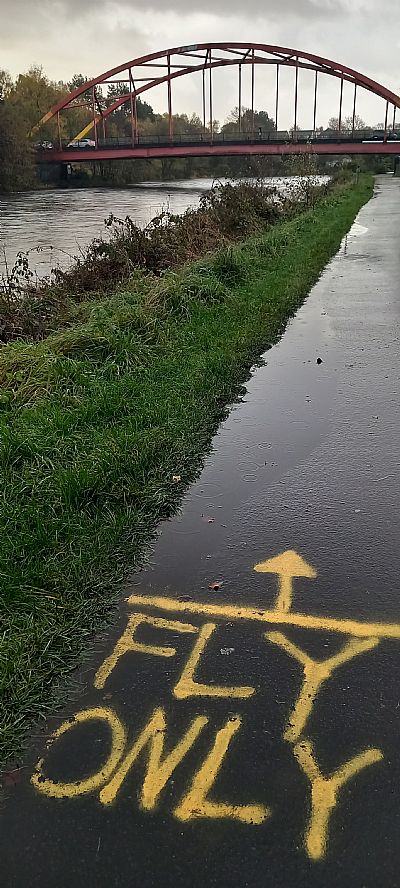
When seeing this sign for the first time, it was suggested that this is as far as one could walk. (Get it?). Actually it refers to angling.
When is graffiti graffiti? The difference between what is acceptable or not seems to be based on maliciousness or perceived need. This is hardly satisfying clarity and the subject is often broad and confusing; always subjective. They should mean something other than rebelliousness and not mar the scene.
Signs appear on some paths such as this one on towpath along the Leven. They may be distance markers for races. This one is mystifying though and if misinterpreted appears to advocate fly-tipping. That is not the issue. The issue is that even comparatively "temporary" spray painted writing, still remains for months, sometimes over a year, is untidy and irresponsible.
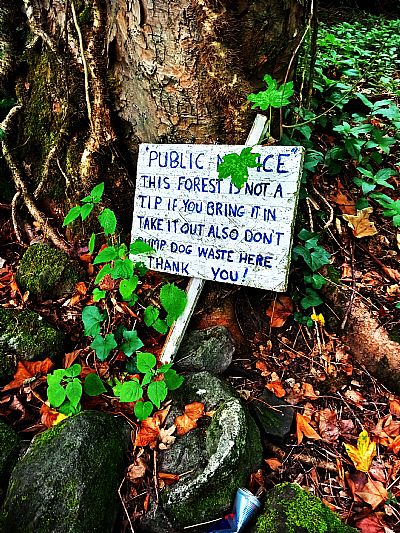
Someone cares. Someone doesn't. The footpath up through Craigandro Wood from Renton towards 100 Steps and Carman Muir.
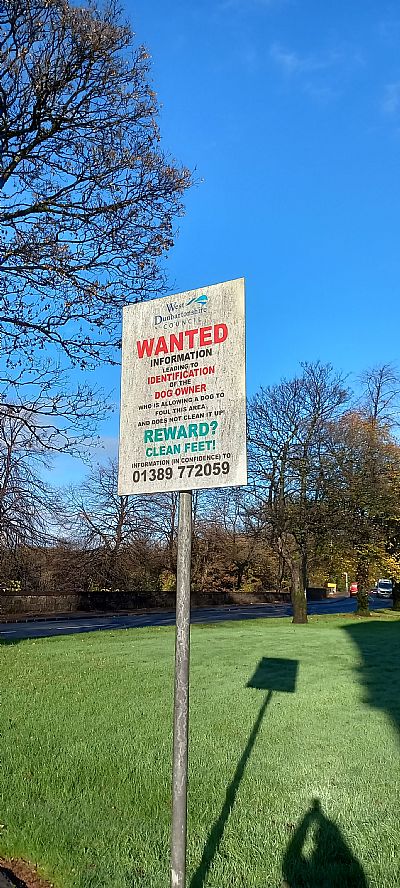
This sign is in Jamestown. Do we now need new signs asking for the old signs to be kept clean?
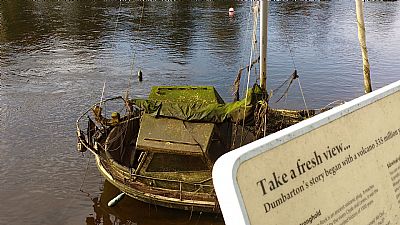
Sometimes there is daft irony. TAKE A FRESH VIEW ... refers to the scene before you, in this case the Leven at Dumbarton, but with a decrepid boat hulk. Can't blame this on any volcano!!
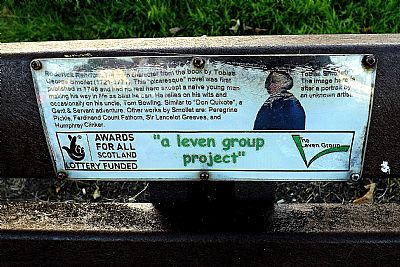
It is great to see efforts to promote the history of the area. we do have information boards for various places of interest, but this small sign and the next were initiatives of the Leven Group some years ago celebrating literature rather than places and things. They are each on benches along the Leven towpath near Alexandria.
The first is about the fictious character of Roderick Random from a book by Tobias George Smollett (17212 - 1771). This "picaresque" novel was the first published in 1748 and had no real hero except a naive young man making his way in life as best he can. He relies on his wits and occasionally his uncle, Tom Bowling.Similar to "Don Quixote", a Gent & a Servant adventure. Other works by Smollett are : Peregrine Pickle, Ferdinand Count Fathom, Sir Lancelot Greaves, and Hunphrey Clinker. (Note the correct spelling of Smollett).
Also see index.asp?pageid=717860 for Smollett's monument and something about the author himself.
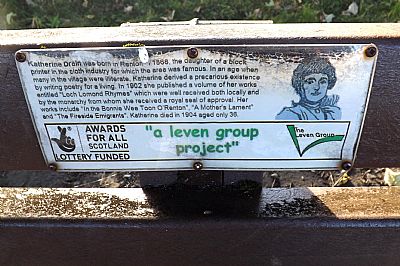
This second sign on a bench celebrates a poet. Katherine Drain was born in Renton in 1868, the daughter of a block printer in the cloth industry for which the area was famous. In an age when many in the village were illiterate, Katherine derived a precarious existence by writing poetry for a living. in 1902 she published a volume of her works entitled "Loch Lomond Rhymes" which were well received locally and by the monarchy from whom she received a royal seal of approval. Her works include "In the Bonnie Wee Toon O'Renton", "A Mother's Lament" and "The Fireside Immigrants". Katherine died in 1902 aged only 36. The Vale of Leven Project website gives more information and offers a download of her book. http://www.valeofleven.org.uk/katherinedrain.html
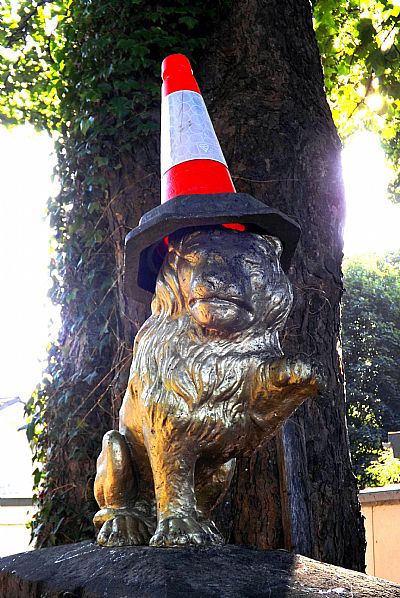
The theme is well known from Wellington's statue in Glasgow so the temptation to put cones on heads at every opportunity can't be resisted. This one was found in Heather Avenue in Alexandria. This coneheid lion down a quite back lane in Alexandria may be a bit of an irritation to the home owner, but as someone supporting Wellington's cone put it, “To keep it coney is to always try and have a giggle and bring good vibes into the world, and even a wee bit of sunshine into the lives of those around you.” [Raymond Hackland]. This small feature has its own share of wry smiles from pasersby. Also see https://inews.co.uk/inews-lifestyle/travel/glasgows-duke-wellington-statue-allowed-keep-cone-53146#The%20Cone%20Controversy

